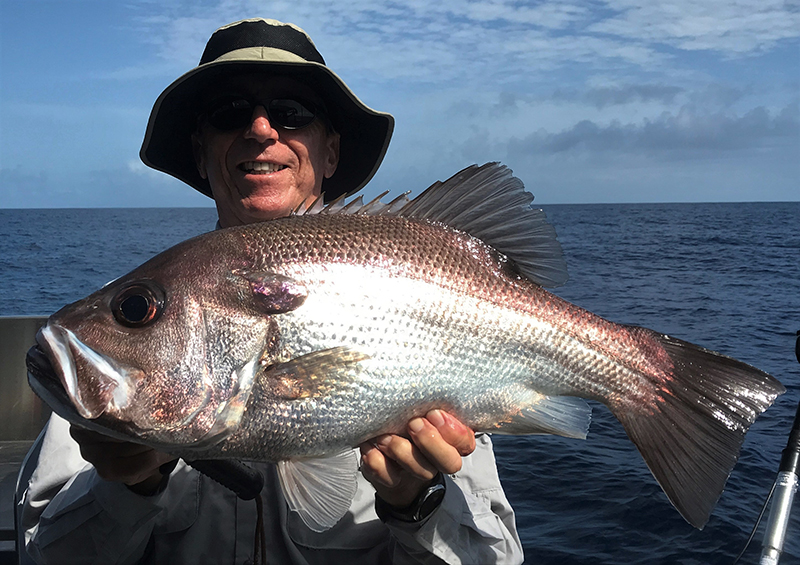Research to gain a better understanding of Pearl Perch biology provides scientific evidence to help fisheries managers reverse a serious decline in stocks.
By Brad Collis
Management options to arrest the decline of Pearl Perch (Glaucosoma scapulare) stocks have become clearer through research that casts new light onto the species’ spawning patterns off the Queensland coast.
Research funded by Fisheries Research and Development Corporation (FRDC) has produced new data on when and where the species spawn, as well as the average age at which Pearl Perch reaches maturity – a critical factor in a fishery’s management.
Principal researcher on the project, Dr Matthew Campbell, from the Queensland Department of Agriculture and Fisheries, says this new information will be important for guiding management options needed to make the fishery sustainable.

Matthew Campbell, Fisheries Biologist with the Queensland Department of Agriculture and Fisheries, with a Pearl Perch caught during field work aimed at assessing the species’ reproductive biology in Queensland. Photo by Mark McLennan.
“It’s a challenge because it won’t be as simple as closing-off an area for a period because the same waters are fished for other species such as snapper,” Matthew explains. “So, any interventions will need to be species-specific.”
The most recent stock assessment for Pearl Perch (published in 2022 and using data up to December 2019) reported that biomass has declined to 22 per cent of the non-fished population benchmark. The Status of Australian Fish Stocks report also lists Pearl Perch as a "depleted" stock". This is considered dangerously close to the 20 per cent level that is an approximate level at which there are insufficient spawning adults to ensure recruitment of the next generation of Pearl Perch.
Matthew explains that one of the issues for Pearl Perch is that it is found in aggregations and tagging indicates that fish tend to stay in the same area.
“So once an aggregation is found, fishers are able to return to the same location and expect to find the fish still there. Both the number and the size of the fish in one large aggregation near K’gari (Fraser Island) was found to decrease over the course of a year as it was repeatedly fished.”
Fishing power
Matthew says another factor fisheries managers consider is the way technology has increased the efficiency of fishing effort or ‘fishing power’.
“The availability of increasingly powerful sonar equipment enables fishers to find Pearl Perch aggregations in deep water and GPS technology allows fishers to pinpoint their location. Fishers can then use electric or hydraulic reels to drop multi-hook rigs to the sea floor and catch a lot of fish quickly,” he says.
The traditional Pearl Perch fishing grounds are located to the south of K’gari in waters less than 100 metres deep. Since 2000, fishers have expanded the fishery, facilitated by this increase in fishing power, to grounds to the east and north of traditional grounds. In these areas, fishers located large aggregations comprised of mostly large, mature fish.

Mark McLennan, Fisheries Technician with the Queensland Department of Agriculture and Fisheries, with a large Pearl Perch caught during field work undertaken in waters north-east of K’gari (Fraser Island). Photo by Matthew Campbell
The biological knowledge gap
To fill the knowledge gaps on Pearl Perch biology, the researchers needed to learn more about the species’ reproduction and movement.
“We needed to understand the average age and length at which they start spawning across the whole fishery. We were also interested in how many eggs Pearl Perch produce and how many times they spawn each season.”
To do this, and with cooperation from fishers, processors and wholesalers, researchers were able to study gonad development throughout the year.
The research indicates that Pearl Perch spawn multiple times each season, corresponding to sea surface temperatures around 26°C, and spawning occurs across the species distribution. Matthew says this complicates the question of how to protect the fish during spawning.
“Species like Tailor and Coral Trout spawn at specific times, making it relatively easy to provide some protection for spawning fish. However, a prolonged spawning season over a large area makes it more difficult to provide adequate protection during Pearl Perch spawning.
“Spatial spawning closures would be inappropriate for Pearl Perch and temporal closures would need to vary across the species’ distribution to account for latitudinal differences in spawning.”
Evidence gain
FRDC Project Manager Toby Piddocke says the latest research has significantly increased knowledge of Pearl Perch biology and created a more complete picture of the population – especially the parts of the population to the north and east of the traditional grounds in southern Queensland and northern NSW.
“The project’s larval distribution modelling, looking at how and where ocean currents carry larvae also revealed that we basically have two separate sources of larvae separated by the currents around K’gari. The project found that very few larvae spawned north of K’gari settle south of there and vice versa. That is an important discovery for defining population structure.”
Toby says the results of the project will be made available to fishery managers and stakeholders for consideration.
Related project
2019-078 - Fishing for change: A social marketing approach to reduce the recreational harvest of Snapper and Pearl Perch in Queensland
This relates to R&D Plan Outcomes 1-3





